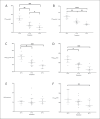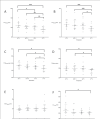Coagulation under Mild Hypothermia Assessed by Thromboelastometry
- PMID: 34539313
- PMCID: PMC8406340
- DOI: 10.1159/000513922
Coagulation under Mild Hypothermia Assessed by Thromboelastometry
Abstract
Introduction: While previous studies have shown a significant impact of extreme hypo- and hyperthermia on coagulation, effects of much more frequently occurring perioperative mild hypothermia are largely unknown. This study therefore aimed to analyze the effects of mild hypothermia using rotational thromboelastometry in vitro.
Materials and methods: Twelve healthy volunteers were included in this study. Standard thromboelastometric tests (EXTEM, INTEM, FIBTEM) were used to evaluate coagulation in vitro at 39, 37, 35.5, 35, and 33°C. Beyond standard thromboelastometric tests, we also evaluated the effects of mild hypothermia on the TPA-test (ClotPro, Enicor GmbH, Munich, Germany), a new test which aims to detect fibrinolytic capacity by adding tissue plasminogen activator to the sample. Data are presented as the median with 25/75th percentiles.
Results: Extrinsically activated coagulation (measured by EXTEM) showed a significant increase in clot formation time (CFT; 37°C: 90 s [81/105] vs. 35°C: 109 s [99/126]; p = 0.0002), while maximum clot firmness (MCF) was not significantly reduced. Intrinsically activated coagulation (measured by INTEM) also showed a significant increase in CFT (37°C: 80 s [72/88] vs. 35°C: 94 s [86/109]; p = 0.0002) without significant effects on MCF. Mild hypothermia significantly increased both the lysis onset time (136 s [132/151; 37°C] vs. 162 s [141/228; 35°C], p = 0.0223) and lysis time (208 s [184/297; 37°C] vs. 249 s [215/358; 35°C]; p = 0.0259).
Conclusion: This demonstrates that even under mild hypothermia coagulation is significantly altered in vitro. Perioperative temperature monitoring and management are greatly important and can help to prevent mild hypothermia and its adverse effects. Further investigation and in vivo testing of coagulation under mild hypothermia is needed.
Keywords: Coagulation; Hypothermia; Rotational thromboelastometry; Thromboelastography; Thromboelastometry.
Copyright © 2021 by S. Karger AG, Basel.
Conflict of interest statement
The authors declare no conflict of interests.
Figures


References
-
- National Collaborating Centre for Nursing and Supportive Care (UK). The management of inadvertent perioperative hypothermia in adults. London: Royal College of Nursing (UK) 2011 - PubMed
-
- Forbes SS, Eskicioglu C, Nathens AB, Fenech DS, Laflamme C, McLean RF, et al. Evidence-based guidelines for prevention of perioperative hypothermia. J Am Coll Surg. 2009 Oct;209((4)):492.e1–503.e1. - PubMed
-
- Melling AC, Ali B, Scott EM, Leaper DJ. Effects of preoperative warming on the incidence of wound infection after clean surgery: a randomised controlled trial. Lancet. 2001 Sep;358((9285)):876–80. - PubMed
-
- Kiekkas P, Fligou F, Igoumenidis M, Stefanopoulos N, Konstantinou E, Karamouzos V, et al. Inadvertent hypothermia and mortality in critically ill adults: systematic review and meta-analysis. Aust Crit Care. 2018 Jan;31((1)):12–22. - PubMed
-
- Dirkmann D, Hanke AA, Görlinger K, Peters J. Hypothermia and acidosis synergistically impair coagulation in human whole blood. Anesth Analg. 2008 Jun;106((6)):1627–32. - PubMed
LinkOut - more resources
Full Text Sources

